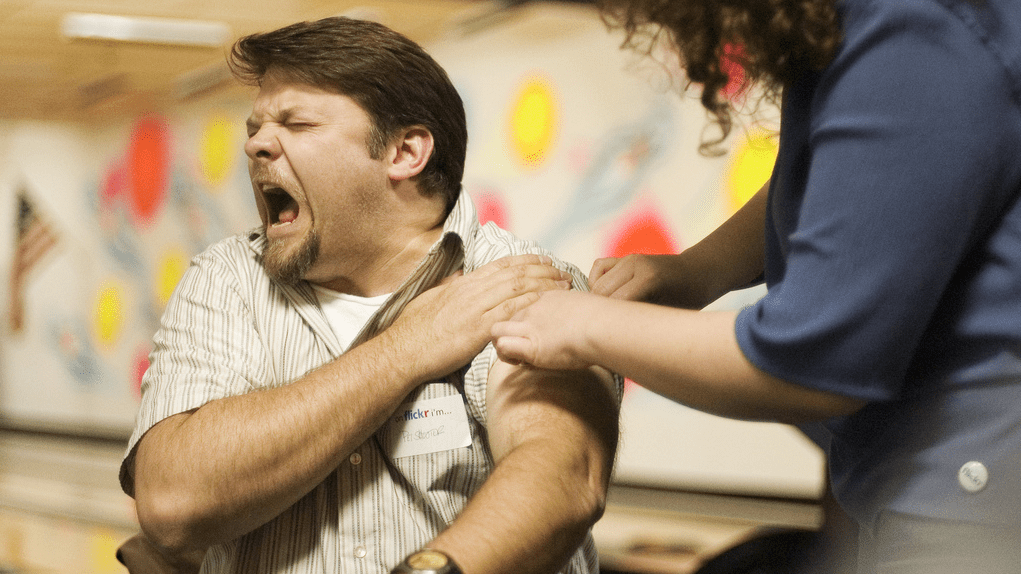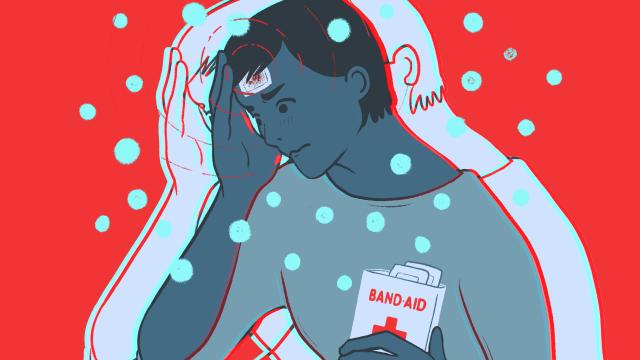Obviously, if you break your leg, you’re going to head straight to the nearest emergency room. But it’s harder to know what to do when you’ve rolled your ankle, or have a nagging pain in your knee. Will you be fine with rest and ice, or do you need to get it checked out?
Illustration by Angelica Alzona. Photos by Mark Lee and via Visualhunt.
We spoke with Dr Bradley Sandella, the program director of sports medicine at Christiana Care Health System, about how to know what common injuries you can handle on your own and when you should see a pro. Here are the warning signs to watch out for:
A Moment When Everything Changed

If you know exactly when you hurt yourself, that’s a sign that your injury may be a significant one. “If you step off a curb and roll your ankle, or you’re in the weight room and you do something and you hear a sudden pop,” Dr Sandella says, you’re more likely to have torn or broken something than if you’re dealing with an ache that developed over time.
Inability to Walk
If you hurt your foot or ankle so badly that you can’t walk a few steps, that’s a sign that you may have fractured a bone. Emergency room providers will use your ability to bear weight on the foot as part of their criteria for deciding if you need an X-ray.
Even if nothing turns out to be broken, it’s also good to seek help for difficulty walking, Dr Sandella says, because over time you can cause or aggravate other problems because of the way that you limp or compensate for the injury.
A Joint that Locks Up or Feels Unstable
If a knee or other joint doesn’t behave like it should, that’s another reason to get checked out. When I tore my ACL, I wasn’t in pain, but my knee felt wobbly whenever I turned a corner. That’s typical of ligament tears, Dr Sandella says. The joint might give way, making you fall, but even a weirdly unstable feeling is a big red flag.
Similarly, it’s not a good sign if a joint seems to stick or lock when you try to move it. That can mean you have a piece of torn cartilage that is getting in the way of the joint’s movement, just like a doorstop prevents a door from closing. Both ligament and cartilage tears are injuries where your doctor may consider surgery, although that depends on the severity and on your personal situation.
A Divot in Your Muscle, or a Muscle Pull That Comes With a Bruise
Muscle pulls, more properly called strains, literally tear apart your muscle tissue. If you only tear a few fibres, that’s a microscopic injury that just causes some soreness, and can easily heal on its own. But it’s also possible to tear so much muscle that you need surgery to put it back together. Somewhere in between are the strains that need to be immobilised, and rehabbed with a special program from a physical therapist.
You’ll know a muscle strain is serious, Dr Sandella says, if there is a “deformity” in the muscle — for example, a divot at the spot that hurts. Bleeding from the muscle can also cause what looks like a gigantic bruise, and that’s another sign that your strain is pretty severe.
Any Symptoms After a Head Injury

Even if you’ve shrugged off head injuries in the past, we now know that concussions can be a lot more serious than they look. Any symptom that follows a head injury is a sign that your brain might have gotten hurt.
That includes dizziness, nausea or confusion, as well as cartoon classics like losing consciousness or seeing double. Even a headache is cause for seeking treatment.
Diagnosing a concussion is especially important for athletes and for kids, because you really don’t want to get a second concussion before you’re fully recovered from the first. Management may be as simple as resting and waiting out the symptoms, but more sophisticated treatments are also becoming available.
Soreness That Gets Worse Over Time
Overuse injuries, like the sore knees and ankles that plague runners, aren’t always cause for concern. If you only hurt while you’re running, Dr Sandella recommends rest and strengthening exercises. If you think you have a form of tendinitis, for example pain in your Achilles tendon, it will heal better if you can avoid anti-inflammatory medicines like Advil during the first two to three days.
These injuries only become a concern when they get worse over time, or if they used to only hurt when you exercise but now also hurt afterwards. That can indicate a stress fracture, especially if the pain is near the bone.
Tendinitis is a short term injury, but it can progress to a chronic condition called tendinosis, which needs more specialised treatment. A physical therapist can give you an exercise program to help your tendon heal. In extreme cases you may require needling or surgery.
How to Get the Best Help

The injuries described here aren’t emergencies. As long as you don’t have signs of a fracture, like an inability to use or move a limb, injuries can usually wait a few days while you decide whether to seek treatment.
A week should be the limit for shoulder and elbow injuries, Dr Sandella says, because you can develop adhesive capsulitis, better known as “frozen shoulder”, if you stop moving your shoulder around. Elbows can develop a similar problem.
When you decide to seek help, you have your choice of providers. The decision comes down to which provider you’re most comfortable with, says Dr Sandella, along with their availability and your insurance coverage.
Your primary care doctor is a great place to start, and if you don’t have one or can’t get in to see her, an urgent care clinic is another good option. If you think your injury is a serious one, it’s fine to go straight to a specialist, like a sports medicine physician. You might also want to see a physical therapist. They can create a specialised exercise plan to help you rehabilitate your injury, and they can also refer you to a doctor if your injury is outside of what they can handle alone.

Comments